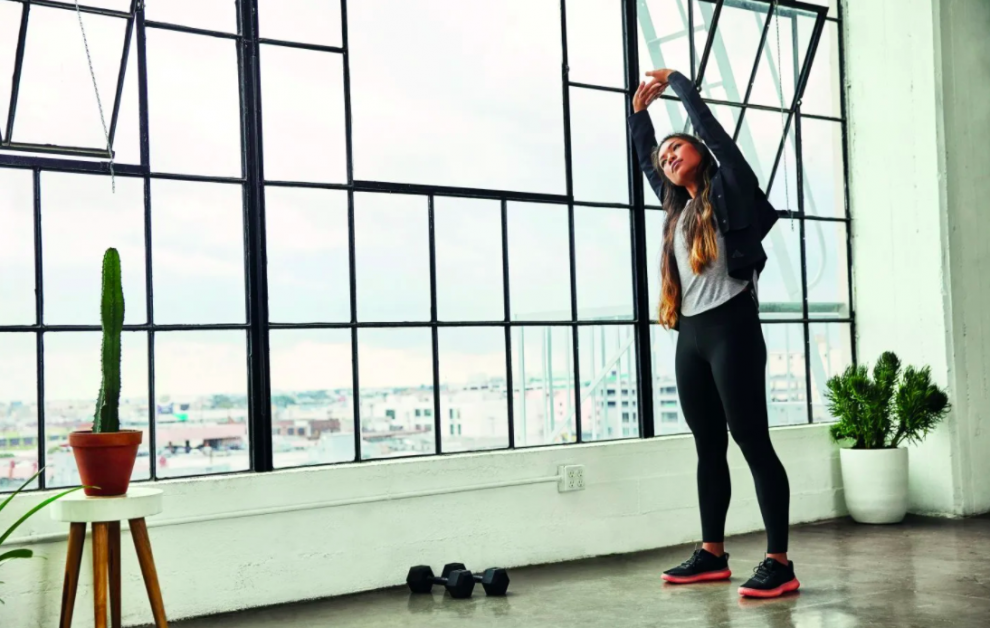“Sitting Is the Worst Position For Your Body”: Experts Advise on Creating a Healthier Home Office

Dr. Steven Weiniger remembers exactly where he was when he became acutely aware of our collective descent into poor posture. The year was 2010; the place, the Orlando, Florida International Airport. “I remember because I am not a fan of Disney World, and that airport is a Mecca for families going to and from the resort,” he says with a laugh. In town for a conference, the Atlanta, Georgia-based chiropractor and world-renowned posture expert noticed a family of four that he observed from the side: “the parents were probably in their forties—the Mom looked like a tennis mom, the Dad was athletic and their heads were slightly forward, which is to be expected,” he recalls. “Usually, the kids look like a version of mom and dad, but younger. But both of these kids—they were maybe 12 and 10—looked like their parents but noticeably more flexed forward. I realized then that these kids were growing up differently than any other humans before them. They know how to swipe before they can speak,” Weiniger continues, describing members of the digital generation who are learning how to think in a completely different way during their most pivotal years of brain development. I’m assuming they’re also learning how to hold and move their bodies in a completely different way to adjust to these tech-motivated behaviors, too, I ask? Weiniger replies with an emphatic, “Bingo.”
[rml_read_more]Even for those of us who precede the Gen Z demographic by one (or two) consonants, the physical effects of being tethered to our devices can be detrimental to our bodies. This has only become more evident as #stayhome protocols have forced many people into home offices, replete with small children and gratitude journals, that more likely resemble “kitchen offices,” “sofa offices,” and even “bed offices.” You’ve likely heard of “tech neck,” the modern-day affliction caused by awkwardly straining your head to better see your phone or computer screen; but the last month has also introduced less buzzy maladies such as “really bad lower back pain” from too many hours spent using the wrong muscles to compensate for poor positioning in an unsupportive chair; “shoulder hunch,” which occurs when an involuntary roundness develops across your clavicles from leaning over a laptop that is positioned way below eye level; and good old “coxic numbness,” when you lose feeling below your tailbone simply from sitting for too long.
“The whole concept of Westernized societies sitting at a desk is a holdover from the industrial revolution,” Weiniger explains, emphasizing that the body is designed to move. “But it’s the world we live in, and it’s not going to change. So the question becomes: How can I adapt my routine and my postural habits, environment, and awareness so I can work from home well?”
Shift Positions
Whatever your set-up is, making an effort to regularly stand up and shift positions is key to preventing pain, soreness, and muscle tension. “You should be shifting positions every two to three minutes, no matter what,” says John Amaral, a Los Angeles-based energy practitioner and trained chiropractor, whose healing work has made Gwyneth Paltrow cry, as the Goop founder recently revealed in an episode of her Netflix series, The Goop Lab. “Then every 30 minutes you need to take a two-minute break where you get up and move. The rule is 30-2,” continues Amaral, suggesting things like full body squats with your arms out, simple back-arching stretches, or “just walking around” as a few ways to spend those two minutes getting your blood flowing and your mobility back. Weiniger ascribes to a similar approach. While talking to me on a headset from his home office he reveals that he has walked out onto his deck and done some stretches on a yoga ball. “That is my habit now,” he says, emphasizing how important it is to make variations of movement a part of your daily routine, mimicking a normal day at the office when you would likely walk to attend meetings, to lunch, or, you know, to speak with other human beings, face to face.
Stand More Than Sit
Amaral’s numeric ratio applies to standing desks, too, he says, endorsing the Silicon Valley staple over sitting, which he calls “the worst position for the body.” Uprite Ergo’s Sit2Stand Work Station is a good investment if you’re looking to acquire some home office furniture, says Weiniger. “But an ironing board also works,” he adds, explaining a few easy hacks to raise the height of your laptop to eye level by stacking household items (books, boxes) on top of a table while distributing your weight on a pressure mat, like SmartCells Anti-Fatigue Mat. To find a neutral standing position, point your toes directly forward as you activate your glutes causing your hips to rotate outwards as you squeeze your inner thighs. With your monitor at eye level, lift your arms to 90 degrees. “And pay attention to where your head is,” suggests Amaral, noting that every inch your head comes forward exerts an extra ten pounds on your spine.
Sit Actively
As I listen to Amaral talk, nodding along in agreement, I realize I am doing the opposite of everything he is saying. I am sitting on a low couch, leaning into a soft cushion, with my feet on a coffee table, and my neck craned downward towards my computer. I haven’t looked more than two feet in front of me—or past my screen—in at least two hours, and I haven’t moved my body for longer. “Well, if you’re going to sit, it’s important to sit properly,” he says, detailing the difference between active sitting—when you’re positioned on the front third of a chair or couch, with your feet flat on the ground and your toes pointed forward, hip length apart, while engaging your glutes, which forces you to engage your core to take you out of a slouch position—and passive sitting: when you are relying on a cushion or the back of a chair for support, tilting your pelvis backwards and your torso forward, causing the muscles in your lower back to work overtime to keep you upright, and creating too much curve in your spine. “It’s better to have a chair that doesn’t have arms,” says Amaral; or you can follow another one of Weiniger’s hacks by using coffee table books to prop up the back legs of a simple kitchen chair, forcing you to lean slightly forward and engage your core. “More important than any of this, though, is being attentive to your body,” suggests Amaral. “ Your body will tell you when it wants to shift potions. People are just so conditioned to ignore and avoid these kind of signals and push through. But you need to learn how to get out of your head.”
Getting out of my head is certainly one of my self-care goals as I isolate with the rest of the world, and hope—perhaps in vain—to come out of this incredibly surreal time with my priorities reordered, having addressed at least some of my shortcomings in the process, postural and otherwise. “You have rounded shoulders, for sure,” my mother confirms on one of our now daily phone calls. A licensed and registered occupational therapist who has spent her career assessing the body and how it relates to an individual’s live/work environment, she would know. “I don’t think you have a forward head, though” she deadpans while returning to a Google search to confirm the name of her preferred lumbar support cushion. We chat briefly about my 2-year-old son, and the minutiae of her InstaCart deliveries, and she suggests I start “deskercising”—doing simple neck rolls and shoulder shrugging movements that can relieve tension caused by poor posture, along with a good ice pack and some Biofreeze. It occurs to me that she’s likely been recommending similar stress-relieving solutions to me my whole life. It’s just that now, perhaps for the first time ever, I am physically—and emotionally—available to hear her. Something for the gratitude journal, then.















Add Comment